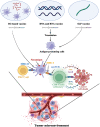Tumor neoantigens: Novel strategies for application of cancer immunotherapy
- PMID: 37415744
- PMCID: PMC10319592
- DOI: 10.32604/or.2023.029924
Tumor neoantigens: Novel strategies for application of cancer immunotherapy
Abstract
Neoantigen-targeted immunotherapy is a rapidly advancing field that holds great promise for treating cancer. The recognition of antigens by immune cells is a crucial step in tumor-specific killing, and neoantigens generated by mutations in cancer cells possess high immunogenicity and are selectively expressed in tumor cells, making them an attractive therapeutic target. Currently, neoantigens find utility in various domains, primarily in the realm of neoantigen vaccines such as DC vaccines, nucleic acid vaccines, and synthetic long peptide vaccines. Additionally, they hold promise in adoptive cell therapy, encompassing tumor-infiltrating cells, T cell receptors, and chimeric antigen receptors which are expressed by genetically modified T cells. In this review, we summarized recent progress in the clinical use of tumor vaccines and adoptive cell therapy targeting neoantigens, discussed the potential of neoantigen burden as an immune checkpoint in clinical settings. With the aid of state-of-the-art sequencing and bioinformatics technologies, together with significant advancements in artificial intelligence, we anticipated that neoantigens will be fully exploited for personalized tumor immunotherapy, from screening to clinical application.
Keywords: Adoptive T cell therapy; Chimeric antigen receptor; Immunotherapy; Tumor vaccine.
© 2023 Guan et al.
Conflict of interest statement
The authors declare that they have no conflicts of interest to report regarding the present study.
Figures



Similar articles
-
Engineering neoantigen vaccines to improve cancer personalized immunotherapy.Int J Biol Sci. 2022 Sep 1;18(15):5607-5623. doi: 10.7150/ijbs.76281. eCollection 2022. Int J Biol Sci. 2022. PMID: 36263174 Free PMC article. Review.
-
Neoantigen vaccine: an emerging tumor immunotherapy.Mol Cancer. 2019 Aug 23;18(1):128. doi: 10.1186/s12943-019-1055-6. Mol Cancer. 2019. PMID: 31443694 Free PMC article. Review.
-
The role of neoantigens in tumor immunotherapy.Biomed Pharmacother. 2022 Jul;151:113118. doi: 10.1016/j.biopha.2022.113118. Epub 2022 May 24. Biomed Pharmacother. 2022. PMID: 35623169 Review.
-
Targeting Tumor Heterogeneity with Neoantigen-Based Cancer Vaccines.Cancer Res. 2024 Feb 1;84(3):353-363. doi: 10.1158/0008-5472.CAN-23-2042. Cancer Res. 2024. PMID: 38055891 Review.
-
Research progress of neoantigens in gynecologic cancers.Int Immunopharmacol. 2022 Nov;112:109236. doi: 10.1016/j.intimp.2022.109236. Epub 2022 Sep 14. Int Immunopharmacol. 2022. PMID: 36113318 Review.
Cited by
-
Trial watch: anticancer vaccination with dendritic cells.Oncoimmunology. 2024 Oct 9;13(1):2412876. doi: 10.1080/2162402X.2024.2412876. eCollection 2024. Oncoimmunology. 2024. PMID: 39398476 Free PMC article. Review.
-
Neoepitope BTLAP267L-specific TCR-T cell immunotherapy unlocks precision treatment for hepatocellular carcinoma.Cancer Biol Med. 2025 Apr 9;22(4):412-32. doi: 10.20892/j.issn.2095-3941.2024.0434. Cancer Biol Med. 2025. PMID: 40205806 Free PMC article.
-
Neoantigen-based immunotherapy: advancing precision medicine in cancer and glioblastoma treatment through discovery and innovation.Explor Target Antitumor Ther. 2025 Apr 27;6:1002313. doi: 10.37349/etat.2025.1002313. eCollection 2025. Explor Target Antitumor Ther. 2025. PMID: 40309350 Free PMC article. Review.
-
Immune evasion in cancer: mechanisms and cutting-edge therapeutic approaches.Signal Transduct Target Ther. 2025 Jul 31;10(1):227. doi: 10.1038/s41392-025-02280-1. Signal Transduct Target Ther. 2025. PMID: 40739089 Free PMC article. Review.
-
Mechanism and application of copper-based nanomedicines in activating tumor immunity through oxidative stress modulation.Front Pharmacol. 2025 Jul 11;16:1646890. doi: 10.3389/fphar.2025.1646890. eCollection 2025. Front Pharmacol. 2025. PMID: 40717985 Free PMC article. Review.
References
Publication types
MeSH terms
Substances
LinkOut - more resources
Full Text Sources
Medical
